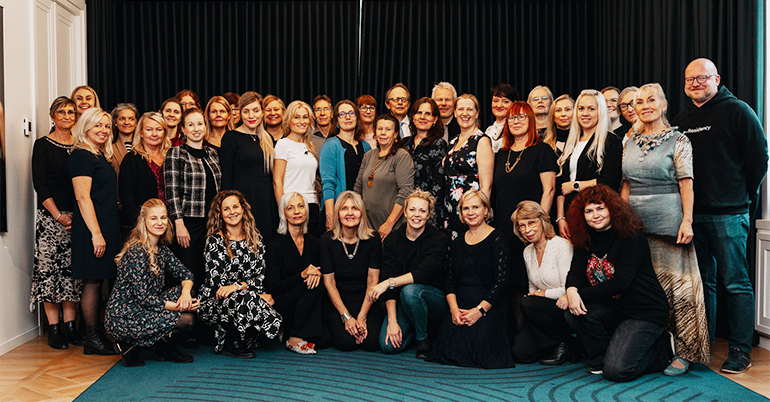Estonian language teachers of Finland meet at the Estonian Embassy in Helsinki
Koidu Oja writes about the life of an Estonian language teacher in Finland.
“Travel from place to place, help people, bring them joy...” These are the lyrics of the fun song Atom-Boy by Arvo Pärt and Vladimir Beekman. The song is about the importance of an invisible little atom, and how it makes our lives better and easier. Arvo Pärt’s music contains the beautiful notion of focusing on every note as a person – a person as a unique blossom.
The work of a teacher of Estonian language and culture in Finland means traveling from place to place with a heap of books and a laptop bag. We all have around 20 hours of work per week and we teach at 1-3 schools in the course of one school day. Some of us travel by their own car, others by foot or bike, by train or by bus. We are happy because the Finnish state is convinced that every mother tongue needs to be preserved and developed. So if the parents desire, a minimum of 4 children is needed for a chance to establish a language class and hire a teacher who is paid by the local government.
This way, depending on the region, every teacher here has 4-100 students. The classes have students of various ages and with different skills from grades 1 to 9. The subject of the lessons is Estonian language and culture. The teaching of home language follows the national curriculum of Finland.

In general, children speak Estonian; they are exposed to the language through their parents or, more rarely, their grandparents. In these classes, we are expanding their vocabulary by reading fresh fiction in Estonian. We are also honing writing skills. We are diving into culture with new children’s films and virtual exhibitions, and we are also getting to know the works of Arvo Pärt and Edward von Lõngus. Various language games are an important part of the lessons, helping students communicate with each other and expand their vocabulary. We can consult other Estonian language teachers on urgent matters online.
The keyword of the Finnish society is modesty. Drawing too much attention to yourself is not the custom nor considered polite. Children are not urged to become better or faster, everyone is allowed to move at their own pace. An Estonian child studying in Finland usually learns to read by the end of 1st grade. This is followed by writing complete sentences. You cannot ask a first-grade student to read a book because not all students have the necessary skills. There are no compulsory reading lists. Children are encouraged to read but there is no control over how much they are actually reading. Reading specific books is only introduced on the higher level of Finland’s lower secondary education. However, we have an agreement among the Estonian teachers here that every Estonian student reads at least one Estonian language book per year. Naturally, we cannot be too demanding either because the national curriculum of Finland is the basis for the native language classes. According to the curriculum, native language lessons (oman äidinkielen opetus) centre on developing communication skills and teaching grammar. The native language lesson is a voluntary lesson that complements all other subjects taught at school. A family can decide to stop these lessons if they feel they’ve become too demanding. Sometimes the lessons are stopped because the family returns to Estonia.
The work of an Estonian language teacher in Finland is a state of impermanence with many variables. Every new school year brings new schools with new students and school leaders. We have no classroom or colleagues, not to mention a common room for teachers where we could have a nice chat over a hot cup of coffee. It makes for a rather lonely daily life. We are preparing the classes in the morning, arrive at the school after the regular classes are over, equipped with a joyful mood and our skills, trying to seize the moment during two hours, and then moving on to another place like little atoms.
Some of us have been working this way for more than a decade now. The threat of burnout is always present. What we, Estonian language teachers in Finland, live and breathe for, is the annual Teacher’s Day organised by the Estonian-Language Education Society and the Estonian Embassy in Helsinki. Through the falling leaves, we rush to Kaivopuisto on the seaside to attend trainings and a formal celebration. On that autumn day, we feel valued. Every spring, a second training is held with the same organisers and the Tuglas Society. For travelling language teachers, the Global Estonian Language Days in March constitute the highlight of the year. This is the time for us to meet our colleagues from across the globe, coming together in various countries. These are our opportunities to meet our professional network and have a rest. At these three meetings, we contemplate the role of a teacher once more, and recharge our batteries to notice every single note in our work.
A huge thank you to you, Estonia, the Ministry of Education, and the Institute! Every training, flower, package of books, lapel pin or cocktail sandwich is needed because they keep us going. “Those who know, go.” (Hando Runnel. „Vajuvate vete laul“)
Koidu Oja
Eestikeelse Hariduse Selts - member of the board







